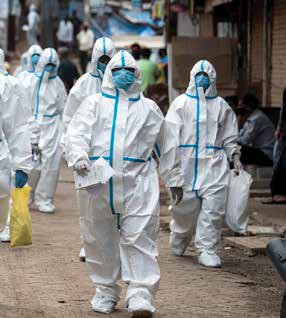
The cloud of COVID Calamity
- bey0ndM@gz!ne
- November 5, 2021
- Cover Story, Covid Stories, Default
- 0 Comments
India has had one of the hardest battles with Covid in both 2020 and 2021. After believing to have fought off the virus in 2020, little did India know that the relief was short-lived.
At the beginning of the year (2020), strict measures were in place to curb the spread of the virus. Citizens were on board. They were following protocol, practicing social distancing, and staying cautious. But somewhere after mid-2020, people threw all caution to the wind. With ‘quick’ developments on the vaccine front, everyone felt reassured. They had hope that good days were coming. As a result, protocols became lax, lockdowns opened, and life returned to ‘normal’.
Little did people know that this newfound belief would not last very long. In 2021, India saw a more catastrophic, deadlier wave of Covid-19. It has claimed more lives in less than three months than we lost in the whole of 2020.
Several reasons have constituted this unstoppable spread of the virus. Of this, the crumbling healthcare sector is the biggest concern. The government’s smugness in ignoring warnings, limited vaccine coverage, and failing crowd restrictions are some of the others.
 5 Apparent Reasons for A More Deadly Second Wave
5 Apparent Reasons for A More Deadly Second Wave
Ignored warnings: India acted with avidity during the first wave. But during the second wave, it was complacent.
- The mutations weren’t tracked. Genome sequencing was being considered as a better form of surveillance for tracking the virus. However, no one paid heed to scientists talking about this.
- With active cases rising, creating containment zones should have been a priority. There was a lot of complacency on this front as well, resulting in an exponential rise in cases.
- India should have learned from other nations such as the UK that the probability of a second wave was high. Protocols and measures to deal with the worst-case scenario should’ve been in place to begin with.
Crumbling healthcare system:
The healthcare system was still reeling from the last wave when the cases started rising again. As a result, there was no way it could take on a pandemic of this scale. There was no space in hospitals, no oxygen available for patients in dire needs. As the death toll increased, testing declined and medical facilities fell short. In several states, the makeshift hospitals set up to deal with the first wave were dismantled and the contractual staff let go.
 The nation lost track:
The nation lost track:
Indian authorities were using the T3 (test, treat, track) protocol during the first wave. This, however, did not accommodate for patients who were asymptomatic and as a result, weren’t getting tested. This was another crucial factor towards the rapid rise in cases. The asymptomatic spread was hard to track. Contact tracing became arduous as there was less awareness. As the restrictions were lifted, large social gatherings, weddings,
and events started taking place. It led to a widespread rise in cases. This in turn caused a lot of people to opt for testing – a rise that the infrastructure wasn’t prepared for.
Lack of adherence to norms:
A major contributor to this tragedy was citizens’ and the government’s callousness towards COVID protocols. On one hand, people started taking the threat lightly. They stopped wearing masks and practicing social distancing. Sanitisation and temperature checking at public places took a backseat. On the other hand, the government stood with the belief that it had won the battle against the virus. They lifted restrictions and even organized full-blown election rallies.
 The struggle for oxygen:
The struggle for oxygen:
One of the key factors for the rising death toll during the second wave was lack of oxygen concentrators for critical patients. The first wave had put light on the need for more ventilators and ICU beds. Not much attention or effort was made to get an adequate supply of oxygen in hospitals. When the second wave arrived early in 2021, India’s medical oxygen supply network collapsed. The massive demand as the cases spiked felt unattainable. Though the production ramped up with time, the initial inadequacy led to deaths in huge numbers.
Overall Outlook
On a global level, countries such as the U.K. and South Africa increased testing and scaled up containment measures after detecting new mutants. It helped them bring down the fatalities quickly.
 One factor to consider with these nations is population. While these methods worked for them, it was unlikely they would’ve worked the same way for India. That is not to say that we couldn’t have handled the situation better. Even without the virus, the medical infrastructure in the country needs a serious overhaul.
One factor to consider with these nations is population. While these methods worked for them, it was unlikely they would’ve worked the same way for India. That is not to say that we couldn’t have handled the situation better. Even without the virus, the medical infrastructure in the country needs a serious overhaul.
The country’s best bet to fight the second wave is a three-fold action. Imposing lockdowns, increasing vaccination drives and simultaneously working the health infrastructure can help get the situation under control.




